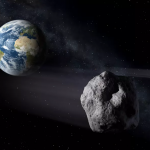Smashing success: NASA asteroid strike results in big nudge0
- From Around the Web, Space
- October 25, 2022
NASA says a spacecraft that plowed into a small, harmless asteroid millions of miles away last month succeeded in shifting its orbit

NASA says a spacecraft that plowed into a small, harmless asteroid millions of miles away last month succeeded in shifting its orbit

It was “probably a once-in-a-lifetime” moment for the asteroid hunter.

A WHOPPING three asteroids will zip past Earth tomorrow ahead of the nerve-shredding pass of an Empire State Building-sized rock next week.

Advances in tech and design are behind this flurry of asteroid missions, as well as the growing interest in asteroids and the danger they pose to Earth.

The historic DART mission is set to launch late Tuesday.

Even though the asteroid Apophis won’t hit Earth for at least another century, its scientific impact will be tremendous.

An amateur astronomer has captured the moment a space rock collided with Jupiter. The debris struck the gas giant, which is the solar system’s largest planet, at 6:39 pm EDT on Monday, creating a flash of light at its surface.

A new study suggests that all living snakes evolved from a handful of species that survived the giant asteroid impact that wiped out the dinosaurs and most other living things at the end of the Cretaceous. The authors say that this devastating extinction event was a form of ‘creative destruction’ that allowed snakes to diversify into new niches, previously filled by their competitors.

2021 PJ1, a near-Earth asteroid between 20 and 30 m (66-98 feet) across, safely flew past Earth on August 14, 2021 at a distance of over 1.7 million km (1 million miles). The approach was historic, marking the 1,000th near-Earth asteroid to be observed by NASA’s planetary radar in just over 50 years.

The newly-discovered asteroid 2021 PH27 has a diameter of about 1 km (3,280 feet) and orbits the Sun in just 113 days — the shortest known orbital period for an asteroid and second shortest for any object in our Solar System after Mercury.